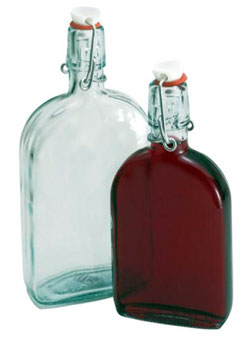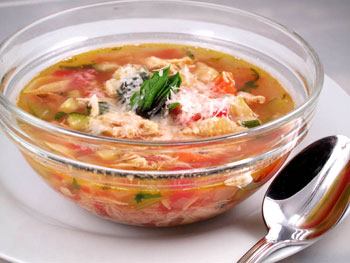|
There’s nothing better than hearty soups during the winter months. When I don’t have time for long simmering stews, I like to turn to this recipe for a super fast soup with lots of flavor. It’s worth using homemade chicken stock, but if you don’t have it on hand, store bought low-sodium broth will do.
Heat oil (or chicken fat) over medium-high heat until shimmering. Add onions, carrots, celery, and zucchini; sauté until softened, about 5 minutes. Add thyme and tomatoes and sauté for 1 minute. Add chicken stock and shredded chicken; simmer until vegetables are tender and flavors meld, 10 to 15 minutes. Add shells and cook until just tender, about 10 minutes. Adjust seasonings, stir in basil, and serve with parmesan cheese on the side. – Recipe courtesy of Cook Like James |
Winter
Winter
Leftover Curried Turkey Salad Sandwich
 I’m calling it…the last of the Thanksgiving leftovers that is. This was truly the end of my turkey…those last two cups of shredded meat. It is December, time to wrap up this turkey thing and move on to the next holiday. However, I do know lots of you also make a gobbler for Christmas, so this recipe might come in handy at the end of the month. You’re welcome:).
I’m calling it…the last of the Thanksgiving leftovers that is. This was truly the end of my turkey…those last two cups of shredded meat. It is December, time to wrap up this turkey thing and move on to the next holiday. However, I do know lots of you also make a gobbler for Christmas, so this recipe might come in handy at the end of the month. You’re welcome:).
I have to say I thought long and hard on how I was going to use up these last bits of the Thanksgiving bird. For me it’s a challenge, there’s no way I’m going to serve it with gravy like the regular holiday meal. I want to make something completely different.
Since it was lunchtime and after I fiddled through the spice cabinet, I decided on this A-M-A-Z-I-N-G sandwich. I added everything I possibly could because texture in a sandwich like this is key. Is has to have crunch.
My husband had it for lunch and requested more for dinner…it was that good. This is definitely a nice way to send off the bird for another year. (Okay I’m lying, I’ve stockpiled two turkeys in my deep freeze. I know I’ll be breaking them out over the winter.)
Winter Citrus
 I know many of you love winter so I shall do my best not to disparage it. However, it’s not my most favorite time of year as I’m a creature of warm weather and open-toed shoes. But if there’s one bright shining spot to the season it’s most definitely citrus. Citrus in any form. When I begin to see the beautiful stacks of pommelos and meyers I can’t help but get excited and my mouth begins to experience sympathy pucker just looking at them.
I know many of you love winter so I shall do my best not to disparage it. However, it’s not my most favorite time of year as I’m a creature of warm weather and open-toed shoes. But if there’s one bright shining spot to the season it’s most definitely citrus. Citrus in any form. When I begin to see the beautiful stacks of pommelos and meyers I can’t help but get excited and my mouth begins to experience sympathy pucker just looking at them.
Not many people realize this, but all citrus fruits come from over 4 million miles away in outer space and magically appear to make our culinary endeavors magical. Alright alright, I know I’m fibbing here but as far as I’m concerned that might as well be my reality. They are some of the most useful fruits on the planet. They preserve, they tang, they balance and they contrast. They do just about everything and anything you need them to do. And they’re equally at home in the savories as they are in the sweets. I told you there were magical!
It’s not unusual to find a big bowl of lemons and limes in my house at all times. I find that with a quick sprinkle of citrus zest even the most basic can be made to shine, not to mention the fact that they’re just so damn gorgeous and cheery, don’t cha think?
Orange Spooner
 Some drinks are just good. Some drinks are good stories with provenance. Some drinks are all the above!
Some drinks are just good. Some drinks are good stories with provenance. Some drinks are all the above!
My Mimi’s people are from the southwest corner of Georgia. Many of her Bainbridge cookbooks are part of my treasured library of culinary literature. Mimi loves to read them and be reminded of all the loved ones she knew growing up and the delicacies they served from their sideboards. This recipe comes from one of these beloved bindings of culinary delights.
But like any good Southern dish, there is a story with this one. Mimi has made this drink for us many a time while growing up and particularly in the wintertime. With truckloads of Florida’s citrus crop crossing the state line and popping up for sale on street corner, farm stands, and markets, oranges and other various and sundry citruses are at their peak. This drink is fantastic with the freshest of Florida’s finest, and I now serve it with a bit of history too.
How To Make Homemade Cordials
From the Huffington Post
 Now that fall is in full swing and you're trying to figure out how to bring back the flavors of the bountiful herbs and produce from the warm summer months, consider using them to infuse alcohols by making your own homemade cordials.
Now that fall is in full swing and you're trying to figure out how to bring back the flavors of the bountiful herbs and produce from the warm summer months, consider using them to infuse alcohols by making your own homemade cordials.
Infusing your favorite alcohols and liquors with herbs and seasonal fruits lends an incredibly aromatic and flavorful combination that really enlivens the palate. To dig a little bit deeper into the world of culinary herbs outside of the conventional ways of using them for savory dishes in the kitchen, you can go out in your own garden, farmer's market, or even the herb section of the market, and "harvest" your own herbs to mix up unique blends and herbal infusions, creating your own personal herbal-infused liqueurs and cordials, using everyday herbs and berries that are readily available in a new and unique way.
When you get the hang of it, try hosting an "herb-harvesting and cordial-making session" with your friends, family, and/or neighbors, and make an entire fun-filled afternoon out of it! Set out pretty colored glass bottles with labels that everyone can infuse, create, and fill to their liking with their own cordial combinations.
More Articles ...
Welcome to the new One for the Table ...
Our Home Page will be different each time you arrive.
We're sure you'll find something to pique your interest...



